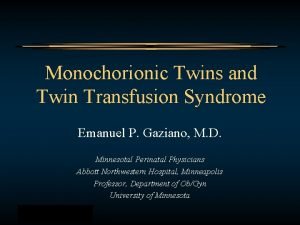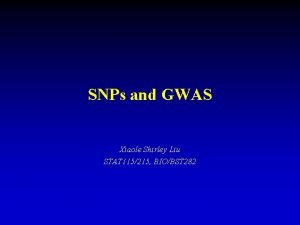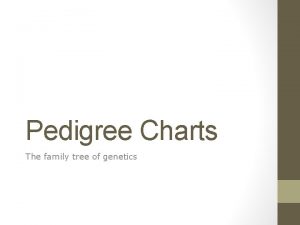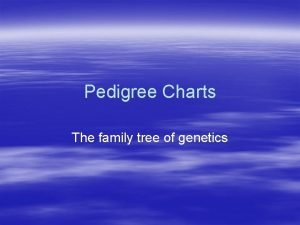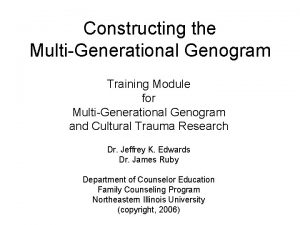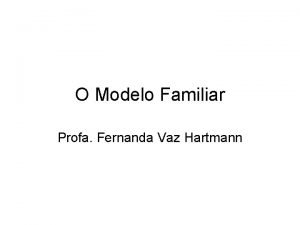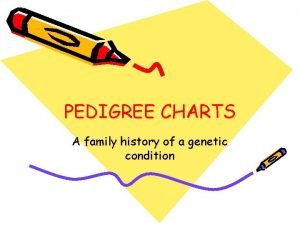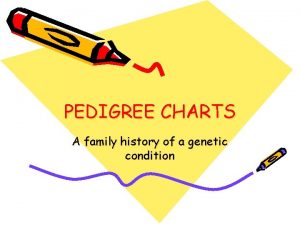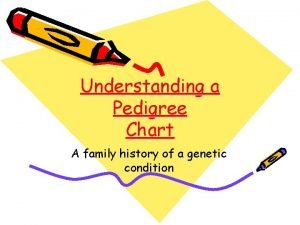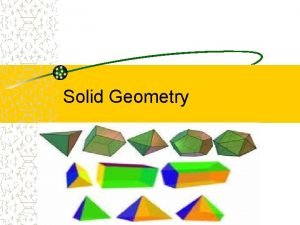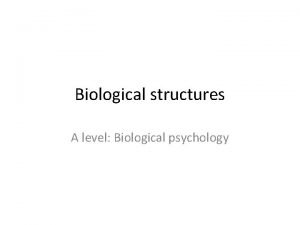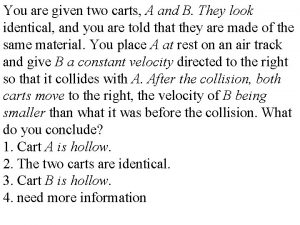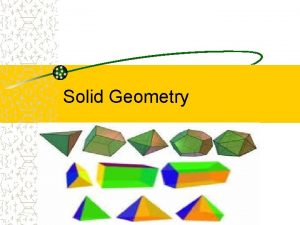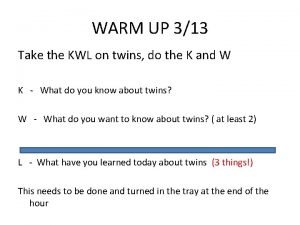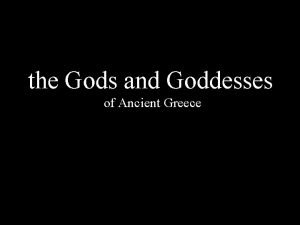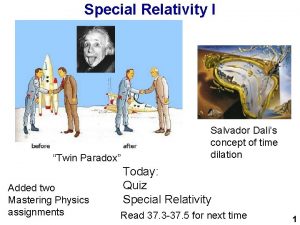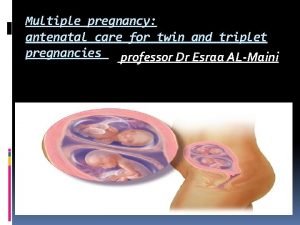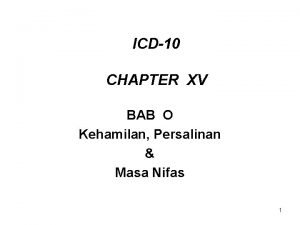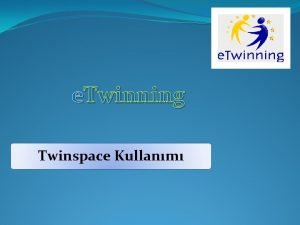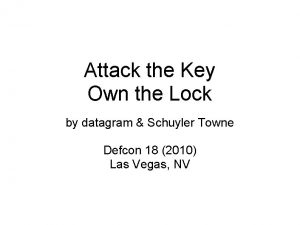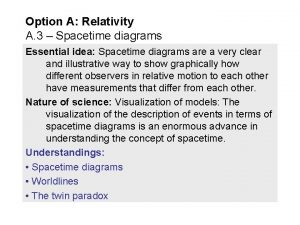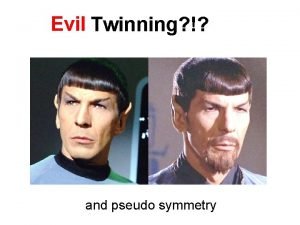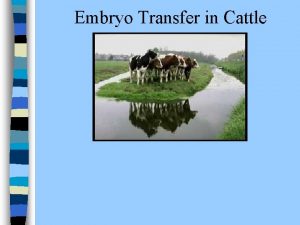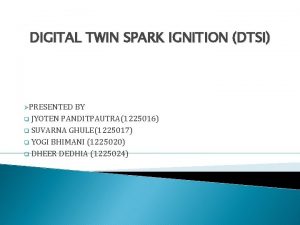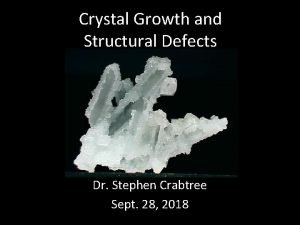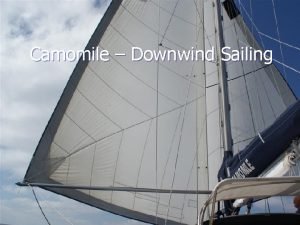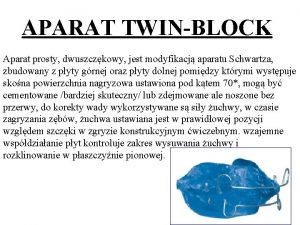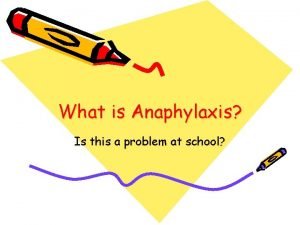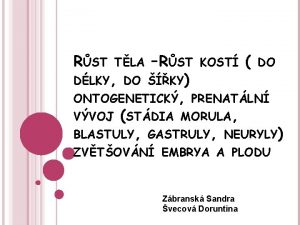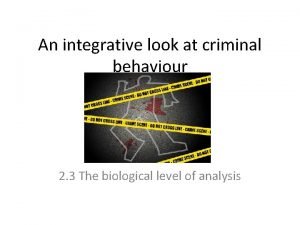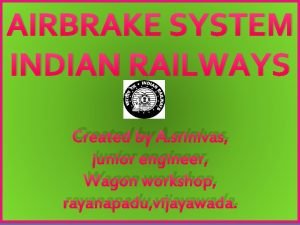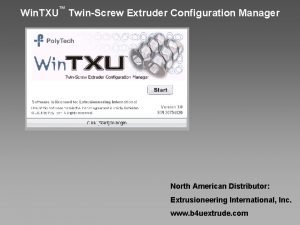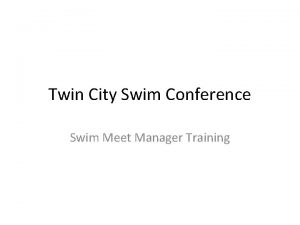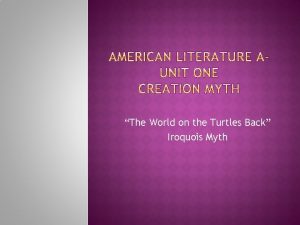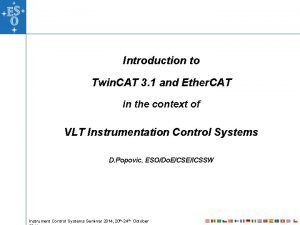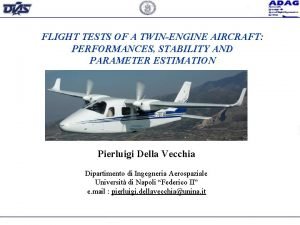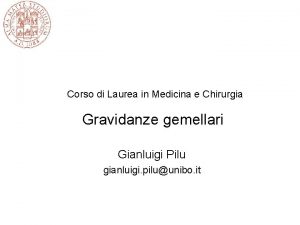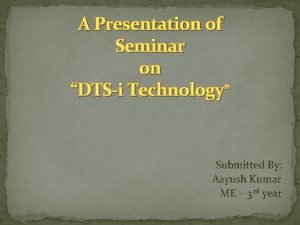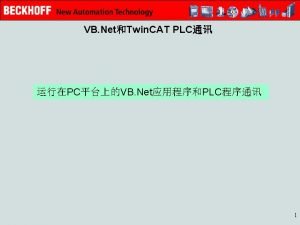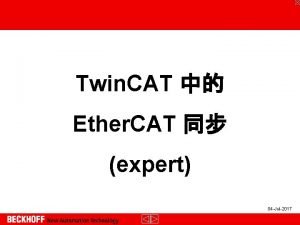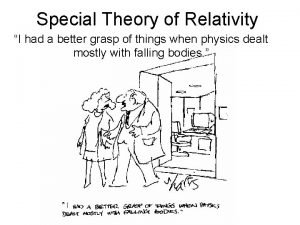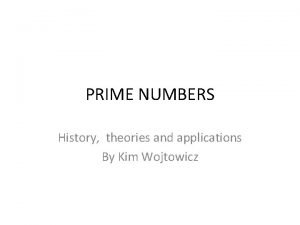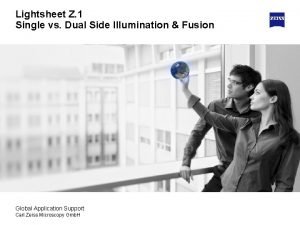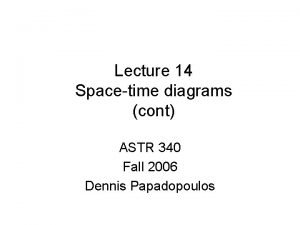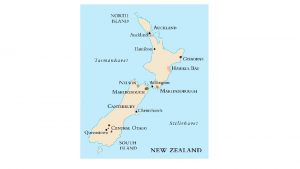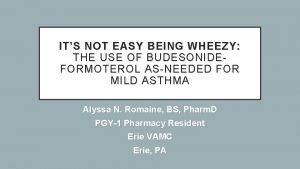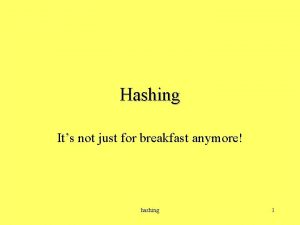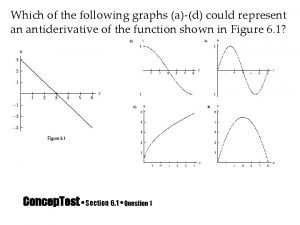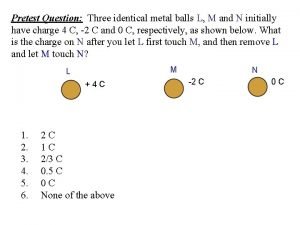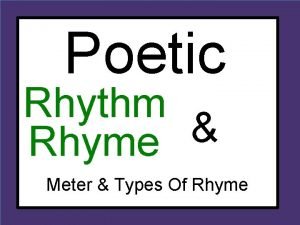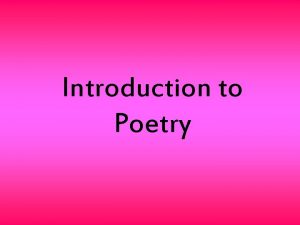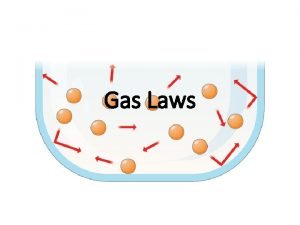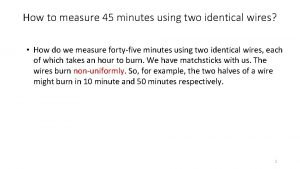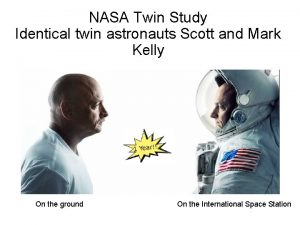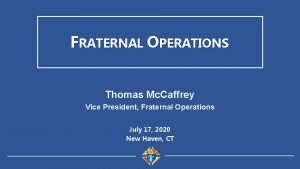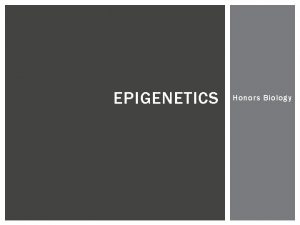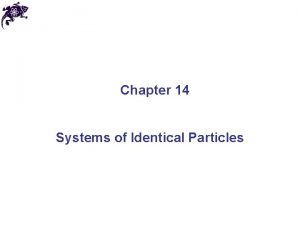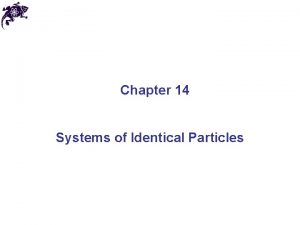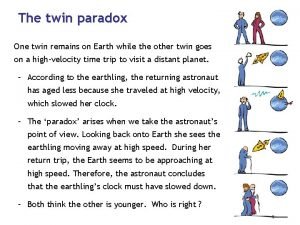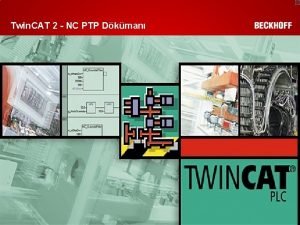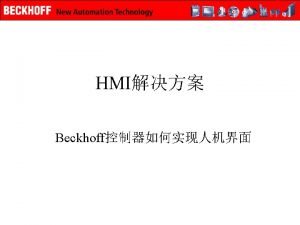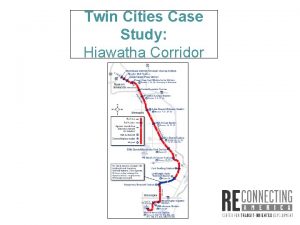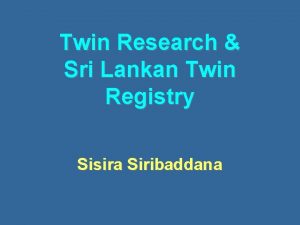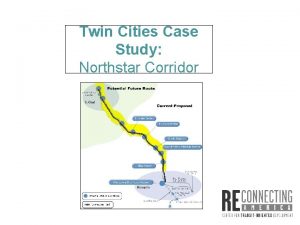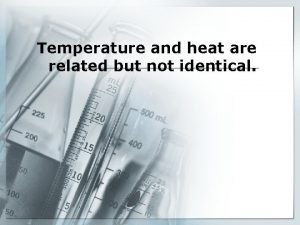And its fraternal twin i e not identical
































































































![All Life Occurs in Ionic Mixtures in which [Ca 2+] is important* as a All Life Occurs in Ionic Mixtures in which [Ca 2+] is important* as a](https://slidetodoc.com/presentation_image_h2/657e28c8a0fb79984691a85ca7a16200/image-97.jpg)















- Slides: 112


And its fraternal twin (i. e. , not identical) in the Philadelphia Museum of Art it is worth a visit, and see the Barnes as well


Mathematics of Molecular Biology Glad to be here! Glad to be able to get here so easily on a nonstop flight from Chicago 4

A few atoms make a BIG Difference Ompf G 119 D Glycine replaed by Aspartate Structure determined by Raimund Dutzler in Tilman Schirmer’s lab Current Voltage relation by John Tang in Bob Eisenberg’s Lab 5

Mathematics of Molecular Biology solving specific Inverse Problems How does it work? How do a few atoms control (macroscopic) Biological Function ? Problem (with noise and systematic error) has actually been solved by Tikhonov Regularization Burger, Eisenberg, Engl (2007) SIAM J Applied Math 67: 960 -989 6

General Theme Mathematics of Molecular Biology is (mostly) Reverse Engineering i. e. , solving specific Inverse Problems How does it work? How do a few atoms control (macroscopic) Biological Function 7

Ion Channels are the Valves of Cells Ion Channels are the Main Controllers of Biological Function Selectivity Ions in Water* are the Different Ions carry Different Signals Liquid of Life *Pure H 2 O is toxic to cells & proteins Hard Spheres Na+ Chemical Bonds are lines Surface is Electrical Potential Red is negative (acid) Blue is positive (basic) Ca++ + 0. 7 nm = Channel Diameter ~30 Å K+ Figure of omp. F porin by Raimund Dutzler 3Å 8

OUTER MEMBRANE

Ion Channels are Biological Devices* Natural nano-valves** for atomic control of biological function Ion channels coordinate contraction of cardiac muscle, allowing the heart to function as a pump Coordinate contraction in skeletal muscle Control all electrical activity in cells Produce signals of the nervous system Are involved in secretion and absorption in all cells: kidney, intestine, liver, adrenal glands, etc. Are involved in thousands of diseases and many drugs act on channels Are proteins whose genes (blueprints) can be manipulated by molecular genetics K+ ~30 x 10 -9 meter Have structures shown by x-ray crystallography in favorable cases *nearly pico-valves: diameter is 400 – 900 x 10 -12 meter; 1 diameter of atom is ~200 x 10 -12 meter 0 Can be described by mathematics in some cases *Device is a Specific Word, that exploits specific mathematics & science

Channels are Selective Molecular Devices Different Ions Carry Different Signals through Different Channels omp. F porin Ca++ Na+ K+ 300 x 10 -12 meter + Diameter matters 0. 7 10 -9 meter = Channel Diameter Ionic solutions are NOT ideal ~3 x 10 -9 meters Classical Biochemistry assumes ideal solutions. K+ & Na+ are identical only in Ideal Solutions. Flow time scale is 10 -4 sec to 1 min 11 Figure of omp. F porin by Raimund Dutzler

Multi-Scale Issues are Always Present in Atomic Scale Engineering Atomic & Macro Scales are both used by channels just because Channels are Nanovalves By definition: all valves use small structures to control large flows 12

Thousands of Molecular Biologists Study Channels as Devices every day, Ion Channel Monthly One protein molecule at a time This number is not an exaggeration. We have sold >10, 000 Axo. Patch amplifiers Axo. Patch 200 B Current Noise Designed at Rush Current Noise Femto-amps (10 -15 A) 13

SINGLE isolated Ry. R Channels in Artificial Planar Lipid Bilayers Axo. Patch-Clamp Amplifier Designed at Rush Planar Bilayer Ca Fused Vesicle Single Channel Current open Experimental Chamber closed Teflon Septa 80 -100 µM Diameter Slide from Mike Fill Thanks! 14

Channel Structure Does Not Change once the channel is open Amplitude vs. Duration Current vs. time Closed 5 p. A 100 ms Open Amplitude, p. A Open Duration /ms Lowpass Filter = 1 k. Hz Sample Rate = 20 k. Hz Typical Raw Single Channel Records Ca 2+ Release Channel of Inositol Trisphosphate Receptor: slide and data from Josefina Ramos-Franco. Thanks!

Where to start? Why not compute all the atoms? 16

Atomic Scale Engineering uses a Few Atoms to Control Macroscopic Flows so Atomic and Macro Scales must be Computed and CALIBRATED together 17

Uncalibrated Simulations will make devices that do not work So far NO simulations have been calibrated for biological solutions They always contain Na+, K+, Cl− and involve Ca 2+ 18

Where to start? Mathematically ? Physically ? 19

. Reduced Models are Needed Reduced Models are Device Equations like Input Output Relations of Engineering Systems The device equation is the mathematical statement of how the system works Device Equations describe ‘Slow Variables’ found in some complicated systems How find a Reduced Model? 20

Biology is Easier than Physics Reduced Models Exist* for important biological functions or the Animal would not survive to reproduce 21

Biology is Easier than Physics because Reduced Models Exist* for important biological functions and are robust or the Animal would not survive to reproduce *Evolution provides the existence theorems and uniqueness conditions so hard to find in theory of inverse problems. (Some biological systems the human shoulder are not robust, probably because they are incompletely evolved, i. e they are in a local minimum ‘in fitness landscape’. I do not know how to analyze these. I can only describe them in the classical biological tradition. ) 22

Multi-scale Engineering is MUCH easier when Reduced Models Exist and are Robust 23

Reduced models exist because they are the adaptation created by evolution to perform a biological function like selectivity Reduced Models and its parameters are found by Inverse Methods of Reverse Engineering 24

Bioengineers: this is reverse engineering Inverse Problems Given the Output Determine the Reduced Model For example, Find Charge Distribution in Channel from Current Voltage Relations Problem (with noise and systematic error) has actually been solved by Tikhonov Regularization Burger, Eisenberg, Engl (2007) SIAM J Applied Math 67: 960 -989 Details are too involved to fit in this talk, sorry to say! using procedures developed by Engl to study Blast Furnaces and their Explosions 25

Bioengineers: this is reverse engineering Inverse Problems Find the Model, given the Output Many answers are possible: ‘ill posed’ * Central Issue Which answer is right? *Ill posed problems with too little data seem complex, even if they are not. Some of biology seems complex for that reason. The question is which ‘some’? 26

Ill posed problems with too little data seem complex even if they are not Some of biology seems complex only for that reason Some* of biology is amazingly Simple ATP as UNIVERSAL energy source *The question is which ‘some’? PS: Some of biology IS complex 27

How does the Channel control Selectivity? Inverse Problems: many answers possible Central Issue Which answer is right? Key is ALWAYS Large Amount of Data from Many Different Conditions Almost too much data was available for reduced model: Burger, Eisenberg and Engl (2007) SIAM J Applied Math 67: 960 -989 Details are too involved to fit in this talk, sorry to say! 28

Inverse Problems: many answers possible Which answer is right? Key is Large Amount of Data from Many Different Conditions Otherwise problem is ‘ill-posed’ and has no answer or even set of answers Molecular Dynamics usually yields ONE data point at one concentration MD is not yet well calibrated (i. e. , for activity = free energy per mole) for Ca 2+ or ionic mixtures like seawater or biological solutions 29

Working Hypothesis: Crucial Biological Adaptation is Crowded Ions and Side Chains Wise to use the Biological Adaptation to make the reduced model! Reduced Models allow much easier Atomic Scale Engineering 30

Physical basis of function Active Sites of Proteins are Very Charged 7 charges ~ 20 M net charge = 1. 2× 1022 cm-3 liquid solid Water is 55 M Na. Cl is 37 M Omp. F Porin Hard Spheres Na+ Ca 2+ + + + K Na+ K+ Ions are Crowded - - Induced Fit of Side Chains 4Å 31 Selectivity Filters and Gates of Ion Channels are Active Sites Figure adapted from Tilman Schirmer

Crowded Active Sites in 573 Enzymes Catalytic Active Site Enzyme Type Protein Density (Molar) Acid (positive) (negative) Basic | Total | Elsewhere 10. 6 8. 3 2. 8 EC 1 Oxidoreductases (n = 98) 7. 5 4. 6 18. 9 12. 1 2. 8 EC 2 Transferases (n = 126) 9. 5 7. 2 16. 6 3. 1 EC 3 Hydrolases (n = 214) 12. 1 10. 7 22. 8 2. 7 EC 4 Lyases (n = 72) 11. 2 7. 3 18. 5 2. 8 EC 5 Isomerases (n = 43) 12. 6 9. 5 22. 1 2. 9 EC 6 Ligases (n = 20) 9. 7 8. 3 18. 0 3. 0 Total (n = 573) Jimenez-Morales, Liang, Eisenberg

Example EC 2: TRANSFERASES UDP-N-ACETYLGLUCOSAMINE ENOLPYRUVYL TRANSFERASE (PDB: 1 UAE) Average Ionizable Density: 19. 8 Molar Functional Pocket Volume: 1462. 40 Å3 Density : 19. 3 Molar (11. 3 M+. 8 M-) Crowded Green: Functional pocket residues Blue: Basic = Probably Positive = R+K+H Red: Acid = Probably Negative = E + Q Brown Uridine-Diphosphate-Nacetylclucosamine Jimenez-Morales, Liang, Eisenberg

Everything Interacts with Everything Else by steric exclusion inside crowded active sites Everything interacts with macroscopic Boundary Conditions (and much else) through long range electric field ‘Law’ of mass action needs to be generalized 34

‘Everything Interacts with Everything Else’ immediately implies the need for Variational Methods for those who understand. But I did not understand for some fifty years, chemists/biologists do not understand even now, so it is not obvious to all I apologize to those who already understand! 35

Here I start from Stochastic PDE and Field Theory Other methods give nearly identical results MSA (Mean Spherical Approximation) SPM (Primitive Solvent Model) Chemistry Models Non-equil MMC (Boda, Gillespie) several forms MATH Field Theory DFT (Density Functional Theory of fluids, not electrons) DFT-PNP (Poisson Nernst Planck) En. Var. A (Energy Variational Approach) Steric PNP (simplified En. Var. A) Poisson Fermi 36

Solved with PNP including Correlations Other methods give nearly identical results MMC Metropolis Monte Carlo (equilibrium only) DFT (Density Functional Theory of fluids, not electrons) DFT-PNP (Poisson Nernst Planck) MSA (Mean Spherical Approximation) SPM (Primitive Solvent Model) En. Var. A (Energy Variational Approach) Non-equil MMC (Boda, Gillespie) several forms Steric PNP (simplified En. Var. A) Poisson Fermi 37

Always start with Trajectories Ze’ev Schuss Department of Mathematics, Tel Aviv University Always start with Trajectories because 1) Trajectories are the equivalent of SAMPLES in probability theory 2) Trajectories satisfy PHYSICAL boundary conditions 3) Trajectories satisfy classical PHYSICAL ordinary differential equations (we hope) 38

From Trajectories to Probabilities in Diffusion Processes ‘Life Work’ of Ze’ev Schuss Department of Mathematics, Tel Aviv University Theory and Applications of Stochastic Differential Equations 1980 Theory and Applications Of Stochastic Processes: An Analytical Approach 2009 Singular perturbation methods for stochastic differential equations of mathematical physics SIAM Review, 1980 22: 116 -155 39 Schuss, Nadler, Singer, Eisenberg

Trajectories in Condensed Phases are Noisy Note: Brownian noise looks the same on all scales! Function has unbounded variation, crossing any line an infinite number of times in any interval no matter how small. Page 40

We start with Langevin equations of charged particles Opportunity and Need Simplest stochastic trajectories are Brownian Motion of Charged Particles Einstein, Smoluchowski, and Langevin ignored charge and therefore do not describe Brownian motion of ions in solutions We use Theory of Stochastic Processes to go from Trajectories to Probabilities Once we learn to count Trajectories of Brownian Motion of Charge, we can count trajectories of Molecular Dynamics Schuss, Nadler, Singer, Eisenberg 41

Langevin Equations Bulk Solution Positive cat ion, e. g. , p = Na+ Negative an ion, e. g. , n = Cl¯ Global Electric Force from all charges including Permanent charge of Protein, Dielectric Boundary charges, Boundary condition charge Schuss, Nadler, Singer, Eisenberg 42

Electric Force in Ion Channels not assumed GLOBAL Electric Force Excess ‘Chemical’ Force from all charges including Permanent charge of Protein, Dielectric Boundary charges, Boundary condition charge, MOBILE IONS Total Force ‘All Spheres” Schuss, Nadler, Singer, Eisenberg Implicit Solvent ‘Primitive’ Model 43

From Trajectories to Probabilities Sum the trajectories Main Result of Theory of Stochastic Processes Sum satisfies Fokker-Planck equation Joint probability density of position and velocity with Fokker Planck Operator Coordinates are positions and velocities of N particles in 12 N dimensional phase space 44 Schuss, Nadler, Singer, Eisenberg

More Math Many papers • We actually performed the sum and showed it was the same as a MARGINAL PROBABILITY estimator of SINGLET CONCENTRATION defined in chemistry • We actually did a nonequilibrium BBGKY expansion with electrostatic & steric correlations • We like everyone else had to assume a closure 1) Nadler, B. , T. Naeh and Z. Schuss (2001). SIAM J Appl Math 62: 443 -447. 2) Nadler, B. , T. Naeh and Z. Schuss (2003). "SIAM J Appl Math 63: 850 -873. 3) Nadler, B. , Z. Schuss and A. Singer (2005). "" Physical Review Letters 94(21): 218101. 4) Nadler, B. , Z. Schuss, A. Singer and B. Eisenberg (2003). Nanotechnology 3: 439. 5) Nadler, B. , Z. Schuss, A. Singer and R. Eisenberg (2004). Journal of Physics: Condensed Matter 16: S 2153 -S 2165. 6) Schuss, Z. , B. Nadler and R. S. Eisenberg (2001). Physical Review E 64: 036116 1 -14. 7) Schuss, Z. , B. Nadler and R. S. Eisenberg (2001). "Phys Rev E Stat Nonlin Soft Matter Phys 64(3 Pt 2): 036116. 8) Schuss, Z, B Nadler, A Singer, R Eisenberg (2002) Unsolved Problems Noise & Fluctuations, UPo. N 2002, Washington, DC AIP 9) Singer, A, Z Schuss, B Nadler, R. Eisenberg (2004) Physical Review E Statistical Nonlinear Soft Matter Physics 70 061106. 10) Singer, A, Z Schuss, B Nadler, R Eisenberg (2004). Fluctuations & Noise in Biological Systems II V. 5467. D. Abbot, S. M. Page 45

Equilibrium Thermodynamics Nonequilibrium Configurations Boltzmann Distribution Trajectories Fokker Planck Equation Schuss, Nadler, Singer & Eisenberg Finite OPEN System Statistical Mechanics Thermodynamics Theory of Stochastic Processes Device Equation 46

Conditional PNP Electric Force depends on Conditional Density of Charge Closure Needed: CORRELATIONS ‘Guess and Check’ Permittivity, Dielectric Coefficient, Charge on Electron Channel Protein Nernst-Planck gives UNconditional Density of Charge Mass Friction Schuss, Nadler, Singer, Eisenberg 47

Probability and Conditional Probability are Measures on DIFFERENT Sets that may be VERY DIFFERENT Consider all trajectories that end on the right vs. all trajectories that end on the left 48

Conditioning and Correlations are VERY strong and GLOBAL when Electric Fields are Involved, as in Ionic Solutions and Channels so cannot do the probability theory without variational methods We had to guess the conditioned sets 49

Schuss, Singer, Nadler and I had to guess the conditioned sets Chun is working on doing this right, Stay Tuned!! PS This is not just of abstract importance. Correlations will be different so results will be different 50

Electric Field Correlates ALL Charges GLOBALLY* Correlation coefficient is 0. 9999999999 from Atomic scale to Macroscopic Boundary EVERYTHING INTERACTS WITH EVERYTHING ELSE including the boundaries “at infinity” Current in a string of chemical reactions A B C violates Kirchff’s Law Kirchoff’s Current Law = Maxwell’s Equations *Maxwell equations are true on all scales INDEPENDENT of the atomic nature of matter, , as an experimental fact Page 51

Here is where we do Science, not Mathematics Here we GUESS and CHECK 52

Everything Interacts Here is where WE GUESS to make “apparently simple” theory! Theory of Stochastic Processes and Thermodynamics Do not deal easily with strong interactions because Interactions are not perturbations Usual Stochastic Processes and Law of Mass Action are not good enough VARIATIONAL METHODS ARE NEEDED! 53

Poisson-Nernst-Planck (PNP) Dielectric Coefficient Poisson’s Equation Proton charge Valence Permittivity Channel Protein Number Densities Drift-diffusion & Continuity Equation Flux Diffusion Coefficient Chemical Potential Thermal Energy Valence Proton charge Thermal Energy Chemical Correlations 54

Semiconductor Equations One Dimensional PNP Dielectric Coefficient Poisson’s Equation Permanent Charge of Protein Valence Proton charge Cross sectional Area Drift-diffusion & Continuity Equation Flux Number Densities Diffusion Coefficient Chemical Potential valence proton charge Thermal Energy 55

Counting at low resolution gives ‘Semiconductor Equations’ Poisson-Nernst-Planck (PNP) Ions are Points in PNP contains only the Correlations of Means Gouy-Chapman, (nonlinear) Poisson-Boltzmann, Debye -Hückel, are siblings with similar resolution but at equilibrium, without current or flux of any species Devices do not exist at equilibrium 56

Solution* of PNP Equation *MATHEMATICS This solution was actually DERIVED by computing many conditional probability measures explicitly by repeated analytical integrations Eisenberg, Klosek, & Schuss (1995) J. Chem. Phys. 102, 1767 -1780 Eisenberg, B. (2000) in Biophysics Textbook On Line "Channels, Receptors, and Transporters" Eisenberg, B. (2011). Chemical Physics Letters 511: 1 -6 Page 57

Please do not be deceived by the eventual simplicity of Results. This took >2 years! Solution was actually DERIVED with explicit formulae for probability measures from a Doubly Conditioned Stochastic Process involving Analytical Evaluation of Multidimensional Convolution Integrals Eisenberg, Klosek, & Schuss (1995) J. Chem. Phys. 102, 1767 -1780 Eisenberg, B. (2000) in Biophysics Textbook On Line "Channels, Receptors, Transporters" Eisenberg, B. (2011). Chemical Physics Letters 511: 1 -6 Page 58

Solution of PNP Equation* *CORRELATIONS: potential profile must be computed by solving electrostatics Page 59

Solution of Langevin Equation Page 60

Solution of Langevin Equation is (exactly) a Chemical Reaction* *CORRELATIONS Potential profile must be computed by solving electrostatics of crowded spheres Page 61

Apparently Simple Treatment of Law of Mass Action Ignores OVERWHELMING effect of Correlations Correlation coefficient (Kirchoff’s law) = 0. 9999999999 Page 62

Tremendous Opportunity for New Mathematics because Classical Chemistry ignores Correlations 63

Classical Chemistry is based on Theory of Ideal Gases without interactions using ‘Law’ of Mass Action 64

Generalization of ‘Law’ of Mass Action is needed because the ‘law’ assumes ‘nothing interacts with nothing’ 65

Traditional Chemical Models depend historically and logically on The Law of Mass Action A, B are assumed to be ideal solutions of noninteracting particles kf, kb are constants independent of concentration of any species Page 66

Law of Mass Action A, B are assumed to be ideal solutions of noninteracting particles kf, kb are constants independent of concentration of any species [ A] means the concentration of species A, i. e. , the number density of A Page 67

‘Law’ of Mass Action assumes Everything is Ideal and Nothing interacts with Nothing but in real ionic solutions (almost) Everything interacts Globally! 68

Ionic Solutions of biology and technology are Complex Fluids and cannot be well analyzed by theory of simple fluids. Only very dilute solutions (Na. Cl<20 m. M) approximate simple fluids. Divalents and mixtures are not simple fluids. All of biology involves mixtures and divalents > 20 m. M. 69

Central Result of Physical Chemistry Ions in a solution are a Highly Compressible Plasma although the Solution is Incompressible Free energy of an ionic solution is mostly determined by the Number density of the ions. Density varies from 10 -11 to 101 M in typical biological system of proteins, nucleic acids, and channels. Learned from Doug Henderson, J. -P. Hansen, Stuart Rice, among others…Thanks! 70

Law of Mass Action with voltage independent constants is Inconsistent with Maxwell and Conservation of Charge if charge is transferred A → B → C 71

Everything is hidden in Keq, kf and kb Interactions exist: k’s and K are functions not constants Page 72

Macroscopic Models are True INDEPENDENT of atomic nature of matter Electric Field Kirchoff’s Current Law = Maxwell’s Equations Correlation coefficient = 0. 9999999999 EVERYTHING INTERACTS WITH EVERYTHING ELSE including the boundaries “at infinity” Current in a string of conductors (drawing on whiteboard) A B C violates Kirchoff’s Law Page 73

with voltage independent constants is Inconsistent with Conservation of Charge if charge is transferred A → B → C, electrical potential must change, and almost always by a large amount 74

Everything is hidden in Keq , kf and kb kf, b and Keq are functions of electrical potential kf, b and Keq cannot be constants in charged systems. All BIOLOGY OCCURS IN CHARGED SYSTEMS Page 75

It is not surprising that Inconsistent Treatments of ionic solutions have been so Unsuccessful despite more than a century of work by fine scientists and mathematicians “It is still a fact that over the last decades, it was easier to fly to the moon than to describe the free energy of even the simplest salt solutions beyond a concentration of 0. 1 M or so. ” Kunz, W. "Specific Ion Effects" World Scientific Singapore, 2009; p 11. 76

Replacement of ‘Law of Mass Action’ is Feasible for Ionic Solutions using VARIATIONAL TREATMENT of the ‘All Spheres’ Model of ionic solutions, ‘liquid of life’ 77

Crowded Channels, Crowded Active Sites are Complex Fluids like liquid crystals of LCD displays All atom simulations of complex fluid are particularly challenging because ‘Everything’ interacts with ‘everything’ else on atomic & macroscopic scales 78

Great Opportunity for New Science Ionic Solutions are Complex Fluids ‘Law’ of Mass Action including Interactions Variational Approach En. Var. A Conservative Derived from theory of Stochastic Processes from Bob Eisenberg p. 1 -6, in this issue Page 79 Dissipative E is Helmholtz free energy Δ is Rayleigh dissipation

Energetic Variational Approach allows accurate computation of Flow and Interactions in Complex Fluids like Liquid Crystals Classical theories and Molecular. Dynamics have difficulties with flow, interactions, and complex fluids Engineering needs Calibrated Theories and Simulations Engineering Devices almost always use flow 80

Energetic Variational Approach En. Var. A Chun Liu Rolf Ryham, Yunkyong Hyon, and Bob Eisenberg Shorthand for Euler Lagrange process with respect to Composite Action Integral, after pullback Variational Principle Mathematicians: two different ‘partial’ variations written in one framework, using a ‘pullback’ of the action integral E is Helmholtz free energy; Δ is Rayleigh dissipation 81

ENERGY TERM conservative Generalization of Helmholtz Free Energy Dielectric from Coefficient Poisson Eq. Number Densities Lagrange Multiplier Eisenberg, Hyon, and Liu En. Vara Variational Analysis of Ionic Solution Page 82

DISSIPATIVE TERM Number Density time Thermal Energy Permanent Charge of protein valence proton charge ci number density; Hard Sphere Terms thermal energy; Di diffusion coefficient; n negative; p positive; zi valence Eisenberg, Hyon, and Liu En. Vara Variational Analysis of Ionic Solution Page 83

Energetic Variational Approach En. Var. A Chun Liu, Rolf Ryham, Yunkyong Hyon, and Bob Eisenberg Mathematicians and Modelers: two different ‘partial’ variations written in one framework, using a ‘pullback’ of the action integral Shorthand for Euler Lagrange process with respect to Action Integral, after pullback Rayleigh Dissipation Function Composite Variational Principle E is Helmholtz free energy Δ Euler Lagrange Equations is Rayleigh dissipation Field Theory of Ionic Solutions that allows boundary conditions and flow and deals Consistently with. Interactions of Components 84

PNP (Poisson Nernst Planck) for Spheres Non-equilibrium variational field theory En. Var. A Nernst Planck Diffusion Equation for number density cn of negative n ions; positive ions are analogous Diffusion Coefficient Thermal Energy Coupling Parameters Ion Radii Poisson Equation Number Densities Dielectric Coefficient valence proton charge Eisenberg, Hyon, and Liu Permanent Charge of Protein 85

Energetic Variational Approach En. Var. A across biological scales: molecules, cells, tissues Variational theory of complex fluids developedby Chun Liu with (1) Hyon, Eisenberg Ions in Channels (2) Horng, Lin, Liu, Eisenberg Ions in Channels (3) Bezanilla, Hyon, Eisenberg Conformation Change of (4) Ryham, Cohen Membrane flow (5) Mori, Eisenberg Water flow in Multiple Scales Voltage Sensor Cells Tissues creates a new Multiscale Field Theory of Interacting. Components needed for Molecular Engineering in general that allows boundary conditions and flow and deals with Ions in solutions self-consistently 86

Generalization of “Law of Mass Action” is feasible for Ions in Channels using the ‘All Spheres’ Model of Channels 87

Three Channel Types Ry. R, Ca. V = EEEE, and Nav = DEKA analyzed successfully* in a wide range of solutions by the ‘All Spheres’ Primitive Model Implicit solvent model of open channel ½ Na+ ½ ½ ½ Na+ ½ ions and protein side chains are hard spheres in this model * Many methods have been used in more than 30 papers since Nonner and Eisenberg, 1998 88

Best Evidence is from the Ry. R Receptor Dirk Gillespie Dirk_Gillespie@rush. edu Gerhard Meissner, Le Xu, et al, not Bob Eisenberg More than 120 combinations of solutions & mutants 7 mutants with significant effects fit successfully

1. Gillespie, D. , Energetics of divalent selectivity in a calcium channel: the ryanodine receptor case study. Biophys J, 2008. 94(4): p. 1169 -1184. 2. Gillespie, D. and D. Boda, Anomalous Mole Fraction Effect in Calcium Channels: A Measure of Preferential Selectivity. Biophys. J. , 2008. 95(6): p. 2658 -2672. 3. Gillespie, D. and M. Fill, Intracellular Calcium Release Channels Mediate Their Own Countercurrent: Ryanodine Receptor. Biophys. J. , 2008. 95(8): p. 3706 -3714. 4. Gillespie, D. , W. Nonner, and R. S. Eisenberg, Coupling Poisson-Nernst-Planck and Density Functional Theory to Calculate Ion Flux. Journal of Physics (Condensed Matter), 2002. 14: p. 12129 -12145. 5. Gillespie, D. , W. Nonner, and R. S. Eisenberg, Density functional theory of charged, hardsphere fluids. Physical Review E, 2003. 68: p. 0313503. 6. Gillespie, D. , Valisko, and Boda, Density functional theory of electrical double layer: the RFD functional. Journal of Physics: Condensed Matter, 2005. 17: p. 6609 -6626. 7. Gillespie, D. , J. Giri, and M. Fill, Reinterpreting the Anomalous Mole Fraction Effect. The ryanodine receptor case study. Biophysical Journal, 2009. 97: p. pp. 2212 - 2221 8. Gillespie, D. , L. Xu, Y. Wang, and G. Meissner, ( De)constructing the Ryanodine Receptor: modeling ion permeation and selectivity of the calcium release channel. Journal of Physical Chemistry, 2005. 109: p. 15598 -15610. 9. Gillespie, D. Boda, Y. He, P. Apel, and Z. S. Siwy, Synthetic Nanopores as a Test Case for Ion Channel Theories: The Anomalous Mole Fraction Effect without Single Filing. Biophys. J. , 2008. 95(2): p. 609 -619. 10. Malasics, A. , D. Boda, M. Valisko, D. Henderson, and D. Gillespie, Simulations of calcium channel block by trivalent cations: Gd(3+) competes with permeant ions for the selectivity filter. Biochim Biophys Acta, 2010. 1798(11): p. 2013 -2021. 11. Roth, R. and D. Gillespie, Physics of Size Selectivity. Physical Review Letters, 2005. 95: p. 247801. 12. Valisko, M. , D. Boda, and D. Gillespie, Selective Adsorption of Ions with Different Diameter and Valence at Highly Charged Interfaces. Journal of Physical Chemistry C, 2007. 111: p. 15575 -15585. 13. Wang, Y. , L. Xu, D. Pasek, D. Gillespie, and G. Meissner, Probing the Role of Negatively Charged Amino Acid Residues in Ion Permeation of Skeletal Muscle Ryanodine Receptor. Biophysical Journal, 2005. 89: p. 256 -265. 14. Xu, L. , Y. Wang, D. Gillespie, and G. Meissner, Two Rings of Negative Charges in the Cytosolic Vestibule of T Ryanodine Receptor Modulate Ion Fluxes. Biophysical Journal, 2006. 90: p. 443 -453. 90

The model predicted an AMFE for Na+/Cs+ mixtures before it had been measured 62 measurements Thanks to Le Xu! Mean ± Standard Error of Mean Note the Scale Gillespie, Meissner, Le Xu, et al 2% error

Evidence in Detail needs another talk ~ 40 papers email me at bob. eisenberg@gmail. com 92

We can actually compute the Structures that determine Selectivity 93

Can En. Var. A actually compute the function of these systems? Can En. Var. A serve as a useful Mathematical Framework for Multi-scale Engineering? 94

The End Any Questions? 95

Multi-Scale Issues Journal of Physical Chemistry C (2010 )114: 20719 Computational Scale Biological Scale Ratio Time 10 -15 sec 10 -4 sec 1011 Length 10 -11 m 10 -5 m 106 Spatial Resolution Three Dimensional (104)3 1012 Volume 10 -30 m 3 (10 -4 m)3 = 10 -12 m 3 1018 10 -11 to 101 M 1012 Solute Concentration including Ca 2+mixtures Atomic and Macro Scales are BOTH used by channels because they are nanovalves so atomic and macro scales must be Computed and CALIBRATED Together This may be impossible in all-atom simulations 96
![All Life Occurs in Ionic Mixtures in which Ca 2 is important as a All Life Occurs in Ionic Mixtures in which [Ca 2+] is important* as a](https://slidetodoc.com/presentation_image_h2/657e28c8a0fb79984691a85ca7a16200/image-97.jpg)
All Life Occurs in Ionic Mixtures in which [Ca 2+] is important* as a control signal Simulations must deal with Multiple Components as well as Multiple Scales This may be nearly impossible for ionic mixtures because ‘everything’ interacts with ‘everything else’ on both atomic and macroscopic scales particularly when mixtures flow *[Ca 2+] ranges from 1× 10 -8 M inside cells to 10 M inside channels 97

Some Details of. Derivation Diffusion as a Chemical Reaction 98

Eisenberg, Kłosek and Schuss (1995). "Diffusion as a chemical reaction: Stochastic trajectories between fixed concentrations. " J. Chem. Phys. 102: 1767�-1780. 99

100

101

102

103

104

Inverse Problem 105

INVERSE PROBLEMS RELATED TO ION CHANNEL SELECTIVITY Martin Burger, Robert S. Eisenberg, and Heinz W. Engl SIAM J. APPL. MATH. 2007 Vol. 67, No. 4, pp. 960– 989

INVERSE PROBLEMS RELATED TO ION CHANNEL SELECTIVITY Martin Burger, Robert S. Eisenberg, and Heinz W. Engl SIAM J. APPL. MATH. 2007 Vol. 67, No. 4, pp. 960– 989 Two classes of inverse problems • Identification problems Determine properties of a real channel (permanent charge and structure), given measurements of the channel current at various different conditions (applied voltages, bath concentrations of the ions). • Design problems consist in determining properties of a synthetic channel such that optimal characteristics are obtained with respect to some criterion (e. g. selectivity with respect to a certain ion species).

Residual and Identification Error No Noise Residual and Identification Error 3% Noise

Ion Channel Problem Poisson: Potential↔ Charge Nernst Planck: Flow, migration and diffusion Potentials μj are computed as Variations of an Energy Functional

Potentials μj are computed as Variations of an Energy Functional Extremum condition for energy functional is the Poisson Equation

Boundary conditions for the ion channel problem Baths Insulating Boundaries Electroneutrality Total Concentration

Measured Output is the Current Flow on One Side where the excess chemical potential is defined by
 Fraternal vs identical twins
Fraternal vs identical twins Twin-twin transfusion syndrome
Twin-twin transfusion syndrome Rumus par stock
Rumus par stock Adoption study
Adoption study Identical by descent vs identical by state
Identical by descent vs identical by state Its not easy but its worth it
Its not easy but its worth it Sadlier level d unit 1 synonyms
Sadlier level d unit 1 synonyms Sareer khan
Sareer khan Twins in pedigree chart
Twins in pedigree chart Akpsi bridge to brotherhood
Akpsi bridge to brotherhood Pedigree affected male symbol
Pedigree affected male symbol Fraternal twins pedigree
Fraternal twins pedigree Paula vertino
Paula vertino Fraternal twins genogram
Fraternal twins genogram El rol de la familia en la educación
El rol de la familia en la educación A familia como o primeiro laboratório
A familia como o primeiro laboratório Conducta fraternal
Conducta fraternal Pedigree chart twins
Pedigree chart twins Fraternal twins pedigree chart
Fraternal twins pedigree chart Fraternal twins pedigree
Fraternal twins pedigree Akpsi bridge to brotherhood
Akpsi bridge to brotherhood The emigree poem
The emigree poem Its halloween its halloween the moon is full and bright
Its halloween its halloween the moon is full and bright Solid
Solid Genotype environment
Genotype environment Rita and holly are identical twins
Rita and holly are identical twins You are given two carts a and b. they look identical
You are given two carts a and b. they look identical Rita and holly are identical twins
Rita and holly are identical twins Rita and holly are identical twins
Rita and holly are identical twins A solid object with two identical ends and flat sides
A solid object with two identical ends and flat sides When a train increases its velocity its momentum
When a train increases its velocity its momentum Sunny cloudy rainy windy
Sunny cloudy rainy windy If its square its a sonnet summary
If its square its a sonnet summary Twin triplets quadruplets quintuplets
Twin triplets quadruplets quintuplets New-twinspace.etwinning.net
New-twinspace.etwinning.net Etwinning space giriş
Etwinning space giriş Twin cities men's center
Twin cities men's center Apollo twin sister
Apollo twin sister Indian burial grounds candy
Indian burial grounds candy Albert einstein twin paradox
Albert einstein twin paradox Twin-track approach
Twin-track approach Monochorionic monoamniotic twins
Monochorionic monoamniotic twins Problems in mathematics education in the philippines
Problems in mathematics education in the philippines Kode icd 10 kala 1 lama
Kode icd 10 kala 1 lama I twin limitless pendrive technology
I twin limitless pendrive technology Evolis elisa
Evolis elisa Twinspice
Twinspice The charity model of disability
The charity model of disability Twin-track approach
Twin-track approach Bar clasp rpd
Bar clasp rpd Twin lakes mongolia
Twin lakes mongolia Mta skeleton key
Mta skeleton key The twin club
The twin club Mcda twin
Mcda twin Digital twin landscape
Digital twin landscape Spacetime diagram examples
Spacetime diagram examples Twin reversed arterial perfusion
Twin reversed arterial perfusion Evil twinning
Evil twinning Horseshoe hose load
Horseshoe hose load N
N Digital twin spark ignition
Digital twin spark ignition Stephen crabtree
Stephen crabtree Twin headsails
Twin headsails Aparat twin block
Aparat twin block Odd one out bell grass metal moon twin vein
Odd one out bell grass metal moon twin vein Twin jet epipen
Twin jet epipen Twin cat 3
Twin cat 3 Acardiac twin
Acardiac twin Pseudo twin
Pseudo twin Christiansen (1977 twin study summary)
Christiansen (1977 twin study summary) Ke type distributor valve
Ke type distributor valve Twin screw extruder animation
Twin screw extruder animation Wenger extruder
Wenger extruder Twin cat 3
Twin cat 3 Twin city swim conference
Twin city swim conference The myth attempts to explain the right handed twin
The myth attempts to explain the right handed twin Stewie's sister
Stewie's sister Arjen jaarsma
Arjen jaarsma Twin cat 3
Twin cat 3 Twin engine aircraft
Twin engine aircraft Corrugated pipe extruder line
Corrugated pipe extruder line Twin placenta
Twin placenta Rufus woods net pens map
Rufus woods net pens map Shoulder loop hose carry
Shoulder loop hose carry Bajaj pulsar 180 dtsi digital twin spark ignition
Bajaj pulsar 180 dtsi digital twin spark ignition Volvo a25 twin steer
Volvo a25 twin steer Cat plc
Cat plc An “evil twin” in the context of computer security is:
An “evil twin” in the context of computer security is: Twin peaks financial regulation
Twin peaks financial regulation Twin cat 3
Twin cat 3 Twin paradox theory
Twin paradox theory Twin prime numbers
Twin prime numbers Dftf 1 twin
Dftf 1 twin Astr twins
Astr twins New world trade center
New world trade center An “evil twin” in the context of computer security is:
An “evil twin” in the context of computer security is: Psy
Psy Twin island vin
Twin island vin Dcma twin cities
Dcma twin cities Too broad too narrow
Too broad too narrow Its not over
Its not over Its not a
Its not a It's not easy being wheezy
It's not easy being wheezy Its not just anymore
Its not just anymore Which of the following graphs are identical?
Which of the following graphs are identical? Warm rhyming words
Warm rhyming words Three identical metal balls
Three identical metal balls Rhyming scheme meaning
Rhyming scheme meaning Twilight poem scan
Twilight poem scan Represented above are five identical balloons
Represented above are five identical balloons It takes ten identical pieces to form
It takes ten identical pieces to form Similar sire similar scion
Similar sire similar scion Measuring 45 minutes with two identical wires
Measuring 45 minutes with two identical wires

